
Molenbeek-Saint-Jean or Sint-Jans-Molenbeek, often simply called Molenbeek, is one of the 19 municipalities of the Brussels-Capital Region, Belgium. Located in the western part of the region, it is bordered by the City of Brussels, from which it is separated by the Brussels–Charleroi Canal, as well as by the municipalities of Anderlecht, Berchem-Sainte-Agathe, Dilbeek, Jette, and Koekelberg. The Molenbeek brook, from which it takes its name, flows through the municipality. In common with all of Brussels' municipalities, it is legally bilingual (French–Dutch).

Richard Colvin Reid, also known as the Shoe Bomber, is the perpetrator of the failed shoe bombing attempt on a transatlantic flight in 2001. Born to a father who was a career criminal, Reid converted to Islam as a young man in prison after years as a petty criminal. Later he became radicalized and went to Pakistan and Afghanistan, where he trained and became a member of al-Qaeda.

Acetone peroxide is an organic peroxide and a primary explosive. It is produced by the reaction of acetone and hydrogen peroxide to yield a mixture of linear monomer and cyclic dimer, trimer, and tetramer forms. The dimer is known as diacetone diperoxide (DADP). The trimer is known as triacetone triperoxide (TATP) or tri-cyclic acetone peroxide (TCAP). Acetone peroxide takes the form of a white crystalline powder with a distinctive bleach-like odor or a fruit-like smell when pure, and can explode powerfully if subjected to heat, friction, static electricity, concentrated sulfuric acid, strong UV radiation or shock. Until about 2015, explosives detectors were not set to detect non-nitrogenous explosives, as most explosives used preceding 2015 were nitrogen-based. TATP, being nitrogen-free, has been used as the explosive of choice in several terrorist bomb attacks since 2001.
Operation Vigilant Guardian was a Belgian army operation following the January 2015 Île-de-France attacks and the dismantling of a terrorist cell in Verviers having foiled attacks imminent, to deal with the terrorist threat and protect the "points" sensitive territory. The operation was put in place 16 January 2015 and ended on 1 April 2021.
On Thursday, 21 July 2005, four attempted bomb attacks by Islamist extremists disrupted part of London's public transport system as a follow-up attack from the 7 July 2005 London bombings that occurred two weeks earlier. The explosions occurred around midday at Shepherd's Bush, Warren Street and Oval stations on the London Underground, and on London Buses route 26 in Haggerston on Hackney Road. A fifth bomber dumped his device without attempting to set it off.

Crime in Belgium is countered by the Belgian Police and other agencies.
Abu Dujana Al-Afghani, or Abu Nayaf al-Afghani was a claimed spokesperson for "Al-Qaeda of Europe" who demanded an end to Spanish support and involvement in the War on Terror. Abu Dujana claimed responsibility for the 2004 Madrid train bombings, as well as a failed train bombing the following month.
A list of suspects and convictions related to the 2004 Madrid Train Bombings.

A series of coordinated Islamist terrorist attacks took place on Friday, 13 November 2015 in Paris, France, and the city's northern suburb, Saint-Denis. Beginning at 21:16, three suicide bombers struck outside the Stade de France in Saint-Denis, during an international football match, after failing to gain entry to the stadium. Another group of attackers then fired on crowded cafés and restaurants in Paris, with one of them also detonating an explosive, killing himself in the process. A third group carried out another mass shooting and took hostages at an Eagles of Death Metal concert attended by 1,500 people in the Bataclan theatre, leading to a stand-off with police. The attackers were either shot or detonated suicide vests when police raided the theatre.

Salah Abdeslam is a Belgian-born Islamic terrorist who was sentenced to life in prison in France in 2022 as the only surviving member of the 10-man unit that carried out the attacks in Paris on 13 November 2015, in which 130 people were killed and more than 490 injured.
On 15 and 18 March 2016, Belgian police carried out raids on houses in Brussels. The raids were conducted in connection to the attacks in Paris four months earlier. In the raids, one suspect was killed and five others were arrested, including Salah Abdeslam, the only surviving member of the 10-man unit that carried out the November 2015 Paris attacks.

On 22 March 2016, two coordinated terrorist attacks in and close to Brussels, Belgium, were carried out by the Islamic State (IS). Two suicide bombers detonated bombs at Brussels Airport in Zaventem just outside Brussels, and one detonated a bomb on a train leaving Maelbeek/Maalbeek metro station in the European Quarter of Brussels. Thirty-two people were killed and more than 300 were injured. Three perpetrators also died. A third airport attacker fled the scene without detonating his bomb, which was later found in a search of the airport. A second metro attacker also fled, taking his bomb with him. The Islamic State claimed responsibility for the attacks.

The Brussels Islamic State terror cell was a group involved in large-scale terrorist attacks in Paris in November 2015 and Brussels in March 2016. The terror cell was connected to the Islamic State (IS), a jihadist terrorist organisation primarily based in Syria and Iraq.
On 5 October 2016, three police officers were attacked by a man wielding a machete in the Schaerbeek municipality of Brussels, Belgium. Two of them suffered stab wounds, while the third was physically assaulted but otherwise uninjured. The suspected assailant, a Belgian citizen named Hicham Diop, was apprehended and charged with attempted terrorism-related murder and participating in a terrorist group.
Events in the year 2017 in Belgium.
This article covers attacks and activity of terrorism in Belgium.
The August 2017 Brussels attack occurred near the Grand-Place/Grote Markt in Brussels, Belgium, on 25 August 2017, when two soldiers were injured by an assailant wielding a knife.

On 15 September 2017, at around 08:20 BST, an explosion occurred on a District line train at Parsons Green Underground station, in London, England. Thirty people were treated in hospital or an urgent care centre, mostly for burn injuries, by a botched, crude "bucket bomb" with a timer containing the explosive chemical TATP. Police arrested the main suspect, 18-year-old Iraqi asylum seeker Ahmed Hassan, in a departure area of the Port of Dover the next day, and subsequently raided several addresses, including the foster home of an elderly couple in Sunbury-on-Thames where Hassan lived following his arrival in the United Kingdom two years earlier claiming to be an asylum seeker.










